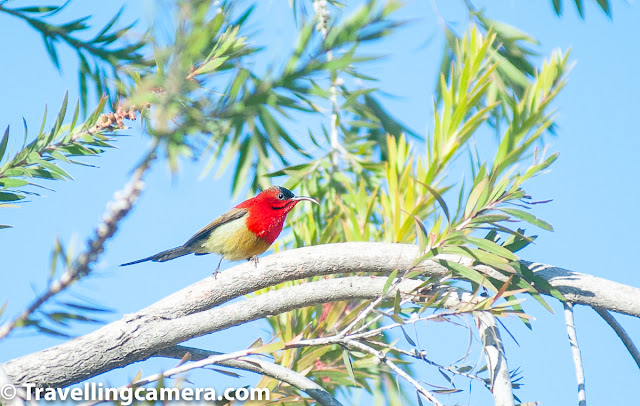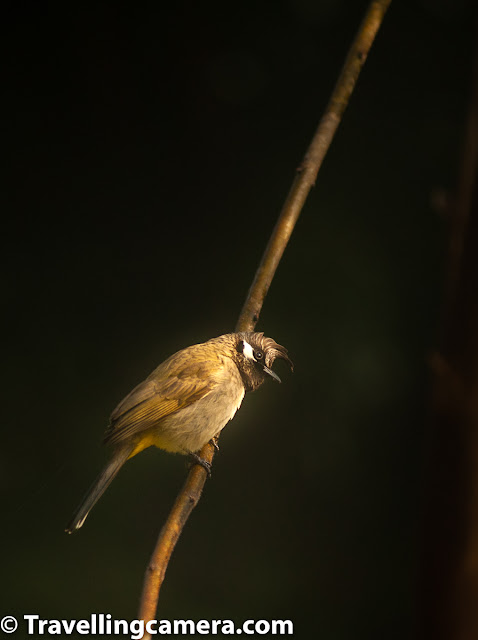 |
| Blue-throated Barbet |
One of the most exciting aspects of our home in Himachal Pradesh is the sheer variety of birds that one can spot there, right from our terrace. The secret behind this is the little stream that flows right behind our house. A dense vegetation that comprises of various types of trees, vines, and shrubs. Apart from leafy trees that provide shade and nesting opportunities, there was fruit trees and vines that provide food. There are also several types of insects that attract flycatchers, thrushes etc.
 |
| Blue-throated Barbet |
It has been six years since we got married and have visited home countless number of times. And we always manage to spot new birds that we have never seen before. And this time was no exception. The first new bird we spotted here was the Blue-throated Barbet. We had seen the Great Barbet earlier, but this was the first time we saw this species. The Chayote vine that my father-in-law had planted has spread across the stream and the Barbets are apparently nesting there and feeding on the chayotes every day. We had to be patient as the Barbets preferred to stay hidden in the vegetation, but finally our patience yielded results and it struck some nice poses.
Related Blogpost - Weekend Birding trip to Pong Dam from Delhi in Winters
 |
| Whistler's Warbler |
The byuns tree (not sure of the name in English) attracts a lot of tiny birds. Mostly it is the Oriental White-eye (now known as the Indian White-Eye) that flock in large numbers on this tree. We assumed that all of these birds were the same, but this time we looked more closely and found that these were in fact mix flocks. One bird that we identified this time was the Whistler's Warbler, which is a tiny bird, smaller than the white-eye. And it was flying around in the foliage, almost hovering like a hummingbird. This cute little bird has stripes on its head and a white patch around its eye, which makes it look similar to the Oriental White-eye.
Related Blogpost - Our trip to the Keoladeo National Park || An Overview
 |
| Blue Whistling Thrush |
One bird that we had seen often but hadn't really been able to identify was a large one that appeared black from a distance and was usually found very close to the stream. It had a yellow beak. This time we happened to spot it in sunlight and noticed that it wasn't actually black, but dark blue in color. And when it took flight, we got to hear its call as well. It was a shrill whistle-like sound. I guess this is where it gets its name - Blue Whistling Thrush.
Related blogpost - Birds of Ayuthhaya || 10-Day Vacation in Thailand
 |
| Unidentified Warbler(?) |
I am pretty sure there were other warblers as well among the tiny yellow birds. I think the one in the above photograph is a kind of Warbler too. There were other birds that we were able to identify but weren't able to click well. Tickell's Blue Flycatcher, Ultramarine Flycatcher, White-capped Water Redstart, Yellow-crowned Woodpecker, Alexandrine Parakeet, Russet Sparrow, Emerald Dove, Red Jungle Fowl, Koklass Pheasant (female), and Common Pheasant (female). It was quite an amazing experience actually. And with each trip where we manage to do some birding, we increasingly miss a good camera and lens. We should really resolve this problem soon.
Related Blogpost - Incredible Birds of Costa Rica || Hummingbirds
 |
| Grey Bushchat (Female) |
From the beak and the overall appearance, this seems to be a flycatcher as well, though I haven't yet been able to identify it. There's a wide variety of flycatchers in our area and almost all of them are brightly colored, pretty birds. This one is plainer, but no less pretty.
Related Blogpost - Incredible Birds of Costa Rica || Motmots, Toucans, Trogons, Quetzals, and Macaws
 |
| Crimson Sunbird |
Sunbirds, though similar to hummingbirds in shape and size, aren't too closely related to them. In fact, a lot of people here in India seem to refer to sunbirds as hummingbirds, but the truth is there are no hummingbirds in India or anywhere in the Eastern hemisphere for that matter. Sunbirds are pretty too though, and this one that we spotted on a bottlebrush tree was one of the prettiest I have ever seen. This is known as a Crimson sunbird and one can rely upon this particular sunbird to visit this particular bottlebrush at the same time during the day and sip on the nectar of bottle brush flowers.
Related Blogpost - Incredible Birds of Costa Rica || Woodpeckers, Flycatchers, Kingbirds, Tanagers, Parakeets, Sparrows, Finches, and Swallows
 |
| Common Tailorbird |
We were at our grandparents' house and I happened to be looking out of their kitchen door when I spotted these cute little birds. At first I thought it was some sort of a warbler but wasn't sure. The birds flew away by the time I got my camera. However, one thing that I have come to appreciate about the mountains is that life there is mostly simple and often predictable. Therefore, I was farely confident that the birds will be back at the same time the next day. I positioned myself close to the spot the next day at the same time, this time equipped with the camera and our inadequate lens. And as predicted, the birds were back at the same time.
Related blogpost - Incredible Birds of Costa Rica || Flycatchers, Warblers, Solitaires, Jays, Egrets
 |
| Common Tailorbird |
Another beautiful thing about the hill creatures is that they trust you and unless you make any sudden movements, they are quite happy coming very close to grab food. It was the same case with these tailorbirds. As it was with the great tit, babblers, sparrows, magpies, and bulbuls. You feel privileged when these beautiful creatures let you photograph them from up close.
Related Blogpost - Birding opportunities around Binsar Wildlife Sanctuary, Uttrakhand, India
 |
| Himalayan Bulbul |
We have photographed this cool dude earlier, but he still manages to fascinate us. And this is also the bird that has been the most generous to us with poses. This is the Himalayan Bulbul, characterized by its mohawk and a yellow vent. We have seen three types of bulbuls - red-whiskered, red-vented, and this one, the Himalayan Bulbul. Of the three varieties, the Himalayan bulbul is the most common followed by the red-vented. It is also the most friendly.
 |
| Indian White-eye |
This is the much-talked about Indian White-eye (earlier known as the Oriental White-eye). Can you guess why it is known as the white-eye? ;-) Because of these incredible eyes, the White-eye can be recognized from a distance, despite its small size. The strange thing about our encounter with this bird is that despite it being present in large numbers around our home, the first time we actually noticed it was in Darjeeling. After that we immediately recognized it at home as well.
Related Blogpost - In search of my winged friends at Okhla Bird Sanctuary, Noida (India)
 |
| Indian White-eye |
These tiny birds bring a lot of life around our home. Their calls wake us up in the morning. They hop around from tree to tree following the sunlight. And when they take flight together, they look like flower petals falling off the trees. They are indeed bright and beautiful creatures and I hope they continue choosing to hang around our home every day. When it comes to birds, it is such colorful little ones that fascinate me more than the large migratory ones. I feel they are magic and nature's gift to us. We must cherish them.
Related blogpost - Birding in Dalhousie, Himachal Pradesh (India)
 |
| Slaty-blue Flycatcher |
This little birdie tested my patience the most. When I first spotted it from a distance I picked up our camera and headed down to the fields. There it kept hopping about in shade, where you cannot get good pictures. Then it flew away. I turned around to go back and just happened to look back. There it was, perched on the branches of this leafless tree in perfect sunlight. And it lingered there for quite some time, striking pose after pose and giving me enough time to click. These pictures helped me identify this bird - Slaty-blue Flycatcher. This is what I was talking about earlier. It takes a while, but birds do oblige you eventually.
Related Blogpost - Millions of Migratory Birds in Pong Wetland, Himachal Pradesh (India)
You just need to hang around for long enough.


.jpg)
Comments